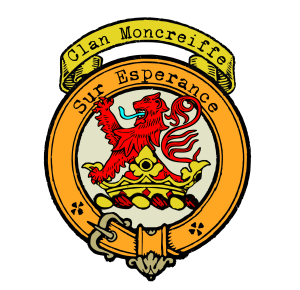Clan Moncreiffe Crest
|
|
CREST: a loin rampant Gules, armed and langued Azure, a chief Ermine Issuing from a crest coronet Or MOTTO: Sir Esperance TRANSLATION: Upon hope VARIATIONS: N/A |
| The name “Moncreiffe” finds its origin in the Gaelic language, specifically “Monach croibhe,” which translates to “Hill of the sacred bough.” This name is derived from the feudal barony of Moncreiffe in Perthshire, Scotland. The clan’s plant badge, the oak, is believed to symbolize the sacred tree, lending further significance to its Gaelic roots.
The Moncreiffe clan’s history can be traced back to the medieval period. In a charter dated 1248, Sir Matthew de Muncrephe was granted lands in Perthshire by Alexander II. Notably, members of the Moncreiffe clan pledged loyalty to Edward I of England in 1296, reflecting the complex political dynamics of the time. |
|
 |
|
| Purchase @ Redbubble Purchase @ Amazon.com Purchase @ Amazon.co.uk |
|
| The clan’s connections with Scottish royalty are evident through its ties to Pictish kings and lands such as Atholl and Dunds. These connections hint at a rich heritage intertwined with the tapestry of Scottish nobility.
The clan’s history is punctuated by prominent individuals who played roles in both local and national affairs. Malcolm Moncreiffe of that Ilk, the sixth Laird, was a council member of James II and saw his estates incorporated into the barony of Moncrieffe. Unfortunately, his legacy was marred by his untimely demise at the hands of Flemish pirates. The Moncreiffe clan’s involvement in significant events like the Battle of Flodden in 1512 and the changing religious landscape showcases their dynamic role in Scotland’s history. The clan’s evolution continued with the creation of baronetcies and the embrace of the Protestant religion. Sir John Moncreiffe, the twelfth Laird, was granted a Nova Scotia baronetcy in 1626. His son, John, was active in raising a company of the King’s Scots Guards under Charles II. Family dynamics also played a pivotal role, with Thomas, a descendant of the eighth Laird, purchasing the barony of Moncreiffe and succeeding to both the chiefship and baronetcy. The Moncreiffe clan’s legacy extends to the architectural realm as well. The construction of a grand country house by Sir William Bruce in 1679 added to the clan’s influence. However, tragedy struck in 1957 when the ancestral seat was ravaged by fire, claiming the life of Sir David Moncreiffe, the twenty-third Laird. The chiefship of the clan passed to the esteemed Sir Iain Moncreiffe, a prominent Scottish herald and historian, whose dedication to preserving the clan’s heritage is commendable. Today, the Moncreiffe clan’s legacy lives on through its descendants and the preservation of its history. The clan’s ties to Scottish nobility, its involvement in key events, and its contributions to Scotland’s cultural and architectural heritage serve as a testament to its enduring impact. The captivating history of the Scottish Clan Moncreiffe reminds us of the intricate tapestry of Scotland’s past, where each clan weaves its unique thread into the vibrant fabric of the nation’s history. |
|
Citations:
|
|

